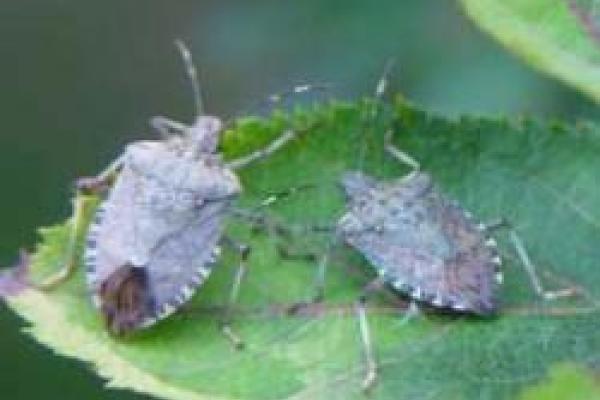Publications by EEOB faculty in 29 May - 10 June 2014

image of Halyomorpha halys by Gary Bernon, USDA-APHIS
The Crypt-Dwelling Primary Bacterial Symbiont of the Polyphagous Pentatomid Pest Halyomorpha halys (Hemiptera: Pentatomidae)
Raman Bansal, Andrew P. Michel, and Zakee L. Sabree. Environmental Entomology 43(3):617-625. 2014. doi: 10.1603/EN13341
Abstract
A recent invader of North America, the brown marmorated stink bug (Halyomorpha halys Stål) is a polyphagous pentatomid that harbors a gammaproteobacterial mutualist in the crypts of specialized midgut gastric caeca (region V4). Histological analyses revealed a single rod-shaped morphology abundant in distal V4 midgut caecal crypts. A strong fluorescence signal was detected when thin sections of these tissues were hybridized with a fluorescently-labeled, Enterobacteriaceae-specific oligonucleotide probe. A single operational taxonomic unit (OTU) assigned to the Pantoea genus represented >99% of 3,454 16S rDNA amplicons obtained from midgut V4 tissues and egg samples. Detection of H. halys primary symbiont in DNA extracted from eggs suggested vertical maternal inheritance as the mode of intergenerational transmission. Consistent detection of the bacterial symbiont in geographically distinct H. halys populations strongly supports an intimate association between these two organisms. An inferred phylogeny of gammaproteobacterial symbionts of pentatomids placed the Pantoea-assigned OTU from H. halys within a clade distinct from primary bacterial symbionts of related stink bugs, Nezara viridula (L.) and Eurydema rugosaMotschulsky. Given these data, Candidatus “Pantoea carbekii” is proposed as the name of the primary bacterial symbiont of H. halys.
Effects of hypoxia on habitat quality of pelagic planktivorous fishes in the northern Gulf of Mexico
Hongyan Zhang, Doran M. Mason, Craig A. Stow, Aaron T. Adamack, Stephen B. Brandt, Xinsheng Zhang, David G. Kimmel, Michael R. Roman, William C. Boicourt, Stuart A. Ludsin. MEPS 505:209-226. 2014. doi:10.3354/meps10768
Abstract
To evaluate the impact of hypoxia ( <2 mg O2 l-1) on habitat quality of pelagic prey fishes in the northern Gulf of Mexico, we used a spatially explicit, bioenergetics-based growth rate potential (GRP) model to develop indices of habitat quality. Our focus was on the pelagic bay anchovy Anchoa mitchilli and Gulf menhaden Brevoortia patronus. Positive GRP was considered high-quality habitat (HQH) and negative GRP was considered low-quality habitat (LQH). Models used water temperature, dissolved oxygen (DO), zooplankton biomass, and phytoplankton concentration collected during the peak periods of hypoxia in 2003, 2004, and 2006 to estimate fish GRP. Results showed that hypoxic areas were always LQH. However, with respect to the entire water column, hypoxia had only a minor impact on overall habitat quality, with habitat quality being driven primarily by prey availability followed by water temperature. These results are in contrast to other ecosystems, such as the Chesapeake Bay, where hypoxia affects a larger fraction of the water column than in the Gulf of Mexico and has a significant impact on overall habitat quality. Differences in the effect of hypoxia on habitat quality between these 2 ecosystems suggest that the vertical extent of hypoxia relative to water column depth (i.e. hypoxic volume) is a fundamental consideration when evaluating the impacts of hypoxia on pelagic fish production.
Relative floral density of an invasive plant affects pollinator foraging behaviour on a native plant
Amy Marie Iler, Karen Goodell. Journal of Pollination Ecology 13:173-183.2014. link to article
Abstract
Interactions between invasive and native plants for pollinators vary from ompetition to facilitation of pollination of native plants. Theory predicts that relative floral densities should account for some of this variation in outcomes, with facilitation at low floral densities and competition at high floral densities of the invader. We tested this prediction by quantifying pollination and female reproductive success of a native herb, Geranium maculatum, in three experimental arrays that varied in floral density of the invasive shrub Lonicera maackii: control (no L. maackii), low floral density of L. maackii, and high floral density of L. maackii. A low density of L. maackii flowers was associated with an increase in pollinator visitation rate to G. maculatum flowers and an increase in conspecific pollen deposition compared to controls and high density arrays. Increased visitation rates were not associated with an increase in the number of visitors to low density arrays, suggesting instead that a behavioural switch in visitation within the array accounted for increased pollen deposition. In contrast, the only evidence of competition in high density arrays was a shorter duration of visits to G. maculatum flowers relative to the other treatments. The number of seeds per flower did not vary among treatments, although trends in seeds per flower were consistent with patterns of pollinator foraging behaviour. Given increased pollinator visits and pollen deposition at a low density of the invader, our study indicates that complete eradication of invasives as a management or restoration technique may have unintended negative consequences for pollination of native plants.
